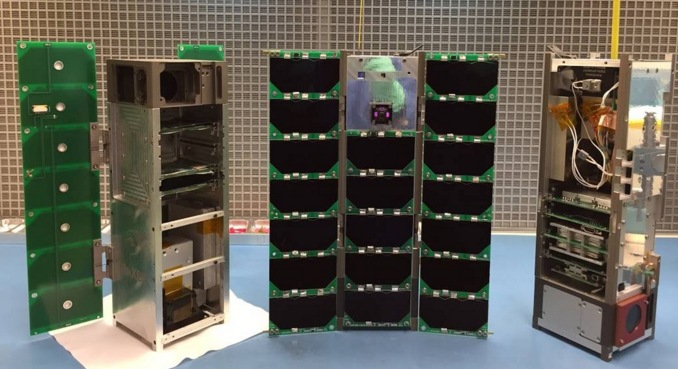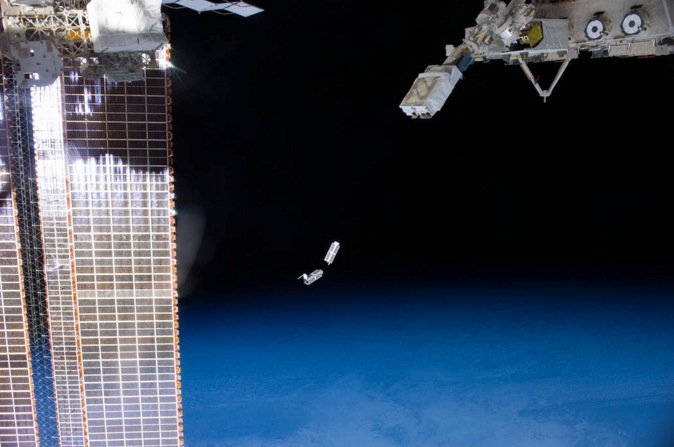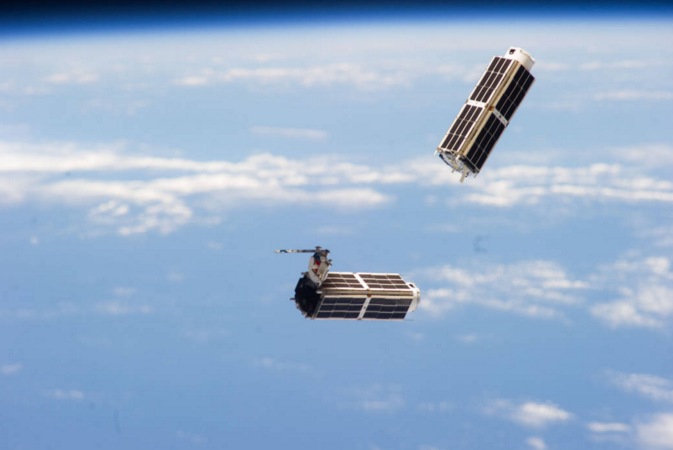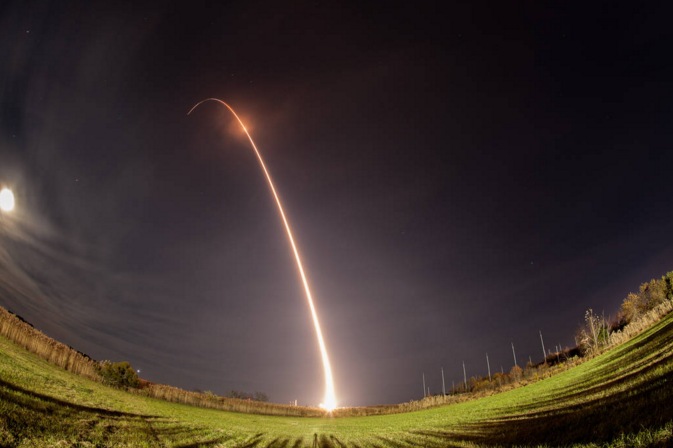NASA offers Venture Class Launch Services contracts for CubeSat satellites

NASA has awarded three contracts amounting to $17.15 million USD for dedicated CubeSat (smallsat) launches as part of its Venture Class Launch Services (VCLS) initiative on October 14, 2015. These initial CubeSat launches are expected to demonstrate the usability of small launch vehicles and reduce the risks associated with such launches. This will eventually open a dedicated and dependable method to get small payloads into space.
A CubeSat is a miniature satellite, generally used for space research, with a 10 cm (4-inch) cube and a mass limited to 1.33 kg. They have emerged over the past 16 years as an economical and time saving way to test a variety of miniature components and technologies which if successful, can be scaled up to much larger mainstream missions. Currently, an average CubeSat launch is 90% cheaper than the most economical standard launcher.
NASA has awarded the CubeSat launch contracts to the following three companies:
- Firefly Space Systems Inc. of Cedar Park, Texas, $5.5 million
- Rocket Lab USA Inc. of Los Angeles, $6.95 million
- Virgin Galactic LLC of Long Beach, California, $4.7 million
The companies are expected to begin demonstration CubeSat launches as soon as 2017 and the first phase of CubeSat launches is expected to be completed by 2018. NASA expects more private sector companies to join the Cubesat specific Venture Class Launches in the near future.
"The award of these contracts represent NASA's investment in the future of the commercial launch industry for SmallSats," said Mark Wiese, chief of the Flight Projects Office for NASA's Launch Services Program, or LSP, based at Kennedy Space Center. "Although the three launch vehicles are new in aerospace, their designs are advanced sufficiently that we feel comfortable relying on them for these missions. The companies have also received interest from other non-NASA customers in using their launch services, leveraging private investment for their development costs, tied to their vision to serve a viable commercial data market."

The NASA-funded MinXSS CubeSat will launch in late 2015 to study soft X-rays from the Sun. Image Credit : NASA
A significant chunk of the CubeSat launches so far have carried Earth observation specific payloads with a single research focus, viz. resource management. This singular focus is expected to continue even as engineers and scientists build modern and capable miniature spacecraft which will offer improved data collection and other technological advances for weather and other geosciences.
"Emerging small launch vehicles have great potential to expand the use of small satellites as integral components of NASA's Earth science orbital portfolio," said Michael Freilich, director of NASA’s Earth Science Division. "Today's CubeSat technology fosters hands-on engineering and flight research training; with the addition of reliable, affordable, and dedicated access to space on small launchers, constellations of SmallSats and CubeSats could revolutionize our science-based spaceborne Earth-observing systems and capabilities. We’re eager to work with the VCLS providers as they develop new launch capabilities for the Earth science community."
NASA’s Launch Services Program (LSP) along with the the Earth Science Division of NASA’s Science Mission Directorate in Washington will jointly fund the awarded VCLS contracts. These initial CubeSat launches are expected to demonstrate the usability of small launch vehicles and reduce the risks associated with such launches. This will eventually open a dedicated and dependable method to get small payloads into space.
"Director Freilich's sponsorship was essential to enabling this class of launch vehicle to become available in the near future," said Jim Norman, director of LSP. "This type of support will allow the US commercial space launch industry to be early to market with this new capability and bodes well for the future."
Currently, CubeSats have piggybacked on larger missions as secondary payloads which are released only after the main payloads are delivered. They have also been launched into space from the International Space Station. However, there has never been a dedicated CubeSat launcher so far.
"The CubeSat and small satellite engineers and scientists are coming up with missions that justify flying unique orbits and at altitudes that are not available if we only fly as secondary payloads," said Garrett Skrobot, lead for the Educational Launch of Nanosatellites, or ELaNa, mission for LSP. "These are still experimental satellites, but the technology they are employing is mature enough to use in these new ways."

Deploying a set of CubeSats from the International Space Station. Image credit: NASA
NASA’s CubeSat Launch Initiative (CSLI) offers a platform to launch CubeSats designed and built by NASA Centers and programs, educational institutions and non-profit organizations. The CLSI encourages students and faculty of educational institutions to build their own CubeSats and offers them a cost effective way to conduct space based research into areas like science, exploration, technology development, education or operations.
Currently, CLSI approved CubeSats are being accommodated and launched via the ELaNa Missions, managed by the Launch Services Program at KSC. However, paucity of payload space has made it impossible to accommodate all the CubeSats and this has led to a backlog of more than 50 missions. This figure does not take into account the new CubeSats that are being developed all the time.
This has led NASA to approach the private sector for dedicated small satellite launch systems. NASA expects commercial competition to drastically reduce the cost of putting a CubeSat into orbit. Commercial launch companies will use rockets to put dozens of CubeSats into orbit at one go. A typical single launch is expected to deploy between 15 to 30 CubeSat payloads.
Cedar Park, Texas based Firefly Space Systems will use its Alpha vehicle to launch CubeSats. The Firefly Alpha is a two stage rocket which will carry payloads up to 400 kg (880 pounds). This allows the Alpha to launch a single small satellite or a mix of smaller CubeSat payloads.
"Being recognized by NASA with a Venture Class Launch Services contract is a tremendous honor for the Firefly team," said Thomas Markusic, Firefly's chief executive officer. "We have worked tirelessly during the last 18 months to develop Firefly Alpha, a vehicle that will be different from anything that has come before it. NASA's vote of confidence in our technology and team is a significant boost to our efforts of making space for everyone.
"VCLS is a vital step in a mission that will grow not only Firefly Space Systems but the small satellite launch industry as a whole," Markusic said. "For many small satellite operators, access to a dedicated and affordable launch vehicle is a real-world stumbling block."

A set of NanoRacks CubeSats is photographed by an Expedition 38 crew member after the deployment by the Small Satellite Orbital Deployer (SSOD). Image credit : NASA
Los Angeles based Rocket Lab USA plans to use its carbon composite Electron rocket for Cubesat launches. The Electron features a unique 3D printed Rutherford engine which adopts an entirely new electric propulsion cycle, using electric motors to drive its turbopumps, and is the first oxygen/hydrocarbon engine to use 3D printing for all primary components. The Electron rocket is designed to carry a 150 kg (330 pounds) nominal payload to a 500-km-high (310 miles), sun-synchronous orbit.
"Rocket Lab USA is looking forward to working to fulfill NASA's Venture Class mission objectives through increased launch opportunities from small, dedicated and affordable launch vehicles," said Peter Beck, Rocket Lab's chief executive officer. "As the vehicle closest to completion in this launch class, we're excited to support NASA and other aerospace companies that have previously been unable to reach orbit due to prohibitive cost and the unavailability of appropriate and timely launch options."
Unlike the competition, Virgin Galactic’s LauncherOne rocket is an air-launched system which can be launched from anywhere in the world. The company has a modern 14 000 m2 (150 000 square foot) manufacturing and design facility in Long Beach, California which employs 150 experienced aerospace professionals.
"We are excited to add NASA to our growing list of customers who have signed contracts to launch small satellites onboard LauncherOne," said Virgin Galactic president Steve Isakowitz. "When paired with affordable and responsive launch vehicles like LauncherOne, small satellites create big opportunities for business and for science. We’re designing LauncherOne to offer market-leading pricing and flexibility to help our customers make the most of their missions, and we are excited to work with NASA to help our nation’s scientists and researchers get their satellites into space."
Both Firefly and Rocket Lab USA are considering launching from the Kennedy Spaceport. However, Virgin Galactic will launch from its base in Mojave, California.

A CubeSat is a relatively inexpensive micro satellite which is designed using modular components which can be built by university and high school students. CubeSats are also designed by technology companies and space organizations like NASA. The basic CubeSat designs have advanced to the point where NASA’s latest InSight Lander mission to Mars also includes a couple of CubeSats. These particular briefcase sized CubeSats have been designed by the Jet Propulsion Laboratory out of modular components and will provide a communications relay to ground stations on Earth as the InSight Lander approaches and lands on Mars.
"The payoff for our CubeSat development work has been everything we had hoped for," Skrobot said. "The whole engineering and research community embraced the opportunity to build these little spacecraft from the start and now we are seeing entrepreneurs apply their own innovations in a variety of ways including launch. It's all coming together to let us use technology to drive exploration further."


A Minotaur I rocket carrying, among other payloads, 11 small cubesat research satellites as part of NASA's fourth Educational Launch of a Nanosatellite (ELaNa) program, lifts off from Virginia's Mid-Atlantic Regional Spaceport Pad 0B at NASA's Wallops Flight Facility. Credit : NASA
A basic CubeSat is extremely compact compared to other spacecraft. CubeSat designers have added deployable antennas and solar arrays, communications systems and even tiny thrusters inside a CubeSat chassis during a mission. As compared to the initial proof of concept missions, the current CubeSats feature advanced mission objectives which may include multiple CubeSats communicating with each other.
Even CubeSat components have become extremely advanced and affordable over time. With current design teams building smaller, more capable sensors, power supplies, instrumentation and communications networks that allow more flexibility and reliability in the CubeSat modules. These miniature sensors and other instruments can and are being used in larger standard space missions where they offer a significant size advantage.
"CubeSats give us a much faster way to test technologies and move their designs up the readiness ladder," Skrobot said. "Even if they don't succeed the first time, a re-flight is not prohibitively costly and designers can apply new components or processes quickly."
The ability to build and launch small satellites is expected to grow exponentially in the United States and also internationally in the near future. CubeSats offer tremendous opportunity to the private sector in the fields of communication, crop monitoring and weather forecasts among other areas.
"We get everything from short emails to full proposals nearly every day that offer compelling missions for these CubeSats and we want to be able to try them out as quick as we can," Skrobot said.
- If you are a space enthusiast and are interested in building a CubeSat, learn more about the CubeSat Launch Initiative (CSLI) through this announcement.
Featured image credit: NASA

Commenting rules and guidelines
We value the thoughts and opinions of our readers and welcome healthy discussions on our website. In order to maintain a respectful and positive community, we ask that all commenters follow these rules:
We reserve the right to remove any comments that violate these rules. By commenting on our website, you agree to abide by these guidelines. Thank you for helping to create a positive and welcoming environment for all.